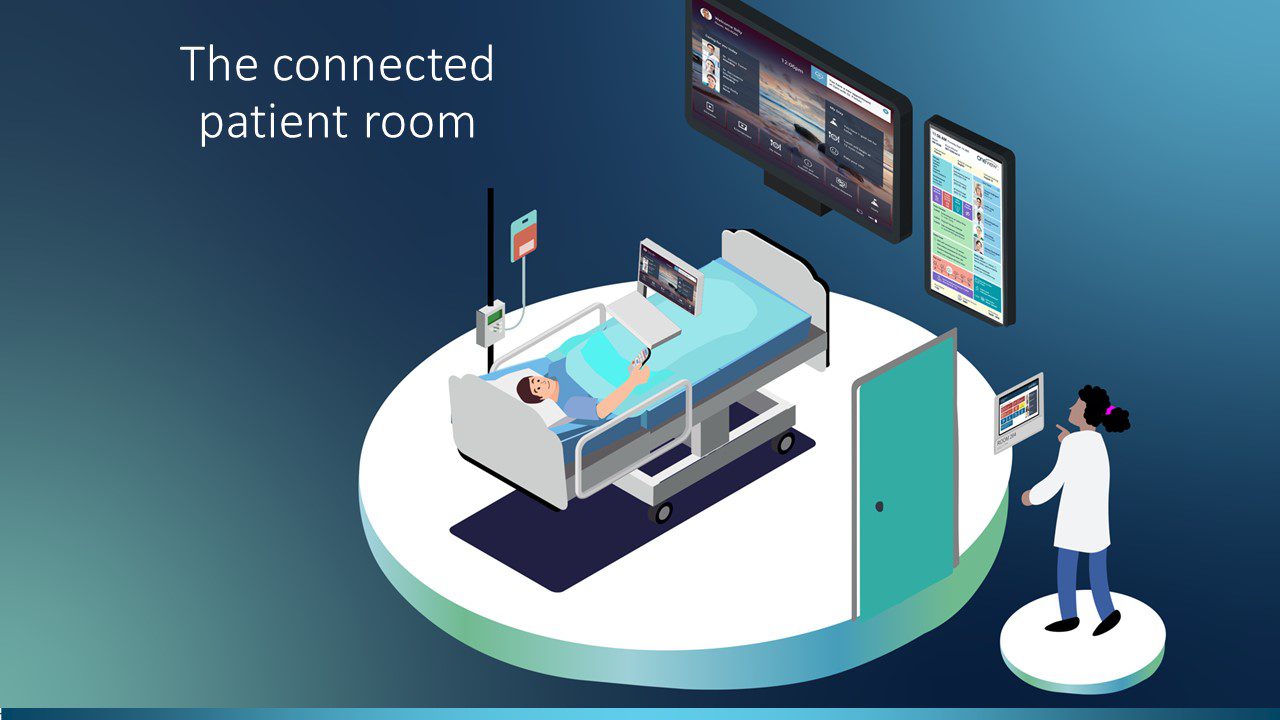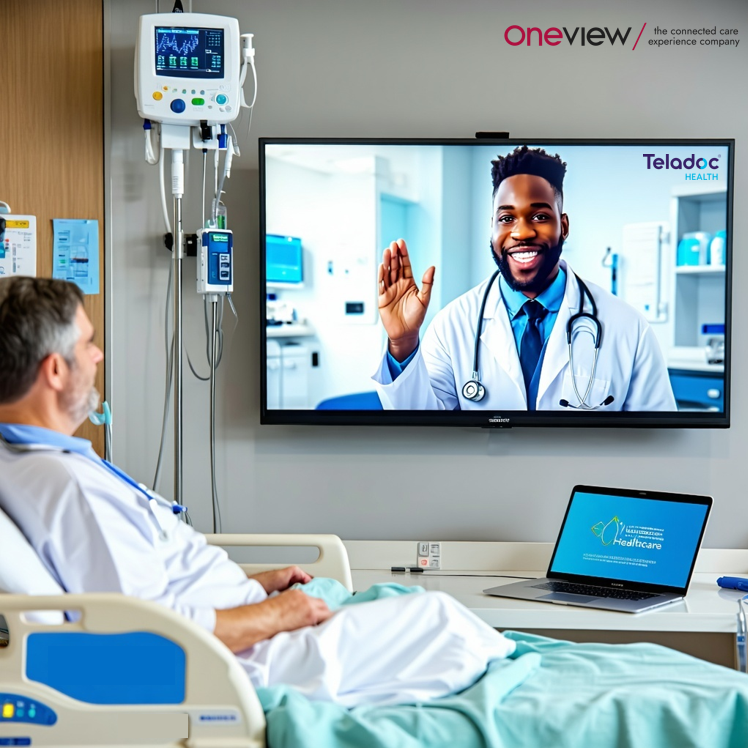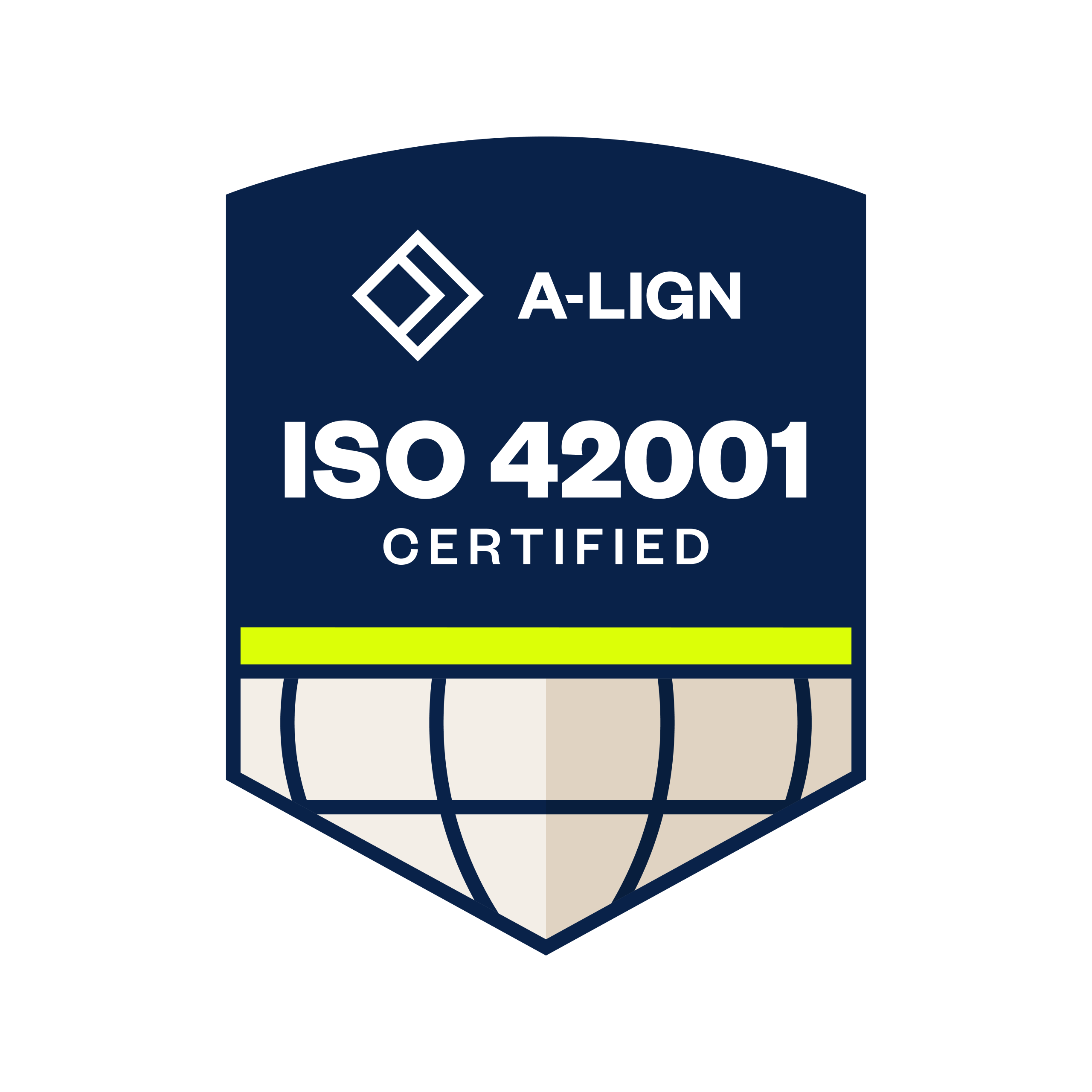Hospital rooms have been undergoing monumental changes in the past 20 years. From infection control to on-demand entertainment, hospitals have been working with new technologies from the floor to the ceiling. Often these technologies come at the intersection of two distinct needs or innovations that, when combined, can also improve patient outcomes and elevate overall patient experience. Below is our list of how the partnership between Oneview and Caregility can create the Connected Patient Room of the future.
What can a Connected Patient Room from Caregility and Oneview provide?
- Engagement tools that restore control to the hands of patients
- Virtual care options through video consultations, rounding and visitation from anywhere
- Tools to allow nurses and healthcare workers to streamline workflows
- AI-based solutions to help measure patients’ recovery progress
The pandemic has changed virtually everything about healthcare. From the way that patients are evaluated to doctor-patient interaction to family involvement, the new digital healthcare experience has challenged our expectations of the delivery of quality care. Leveraging technology to enable doctors to interact more efficiently and virtually with patients has sprung from the parallel needs of patient care and healthcare workers’ to be both safe and effective in their role. Technology for outpatient and acute care facilities has been adopted for both patient and doctor interactions. Interactions are enhanced through virtual visits, while mundane, repetitive and non-patient care related tasks for healthcare workers can effectively be eliminated.
But what is on the horizon for the next tech innovation within the hospital walls? Oneview Healthcare and Caregility have entered a strategic partnership to bring the hospital room of the future one step closer with virtual care on the patients’ television or tablet and powered by artificial intelligence (AI) capabilities.
Engagement tools that restore control to the hands of patients
With the implementation of interactive patient experience (PX) platforms in hospital rooms and at the bedside, patients can now better engage in their own healthcare journey. This ensures they’ll have better, more accurate, and timely information about their healthcare team, care plan, medications, condition specific education, and how best to manage their health after they leave the hospital. PX platforms, such as Oneview’s Care Experience Platform, are designed to balance entertainment with information and allow the hospital to streamline service requests, nurse communications, and health education documentation, in addition to specialized diets and room service meal ordering.
Virtual care options through video consultations, rounding and visitation from anywhere
Nurses and healthcare workers can also benefit from this technology in streamlining clinical workflows. The results help the entire nursing and support team to be more responsive to the needs of individual patients. With video conferencing capabilities, such as Caregility’s iConsult Mobile Bedside app deployed on Oneview tablets at the bedside, hospitals can leverage tools like virtual consults, virtual rounding, video for language interpreters, and virtual visitation by friends and family. Not surprisingly, both patients and healthcare workers generally have a positive attitude toward using technologies like video conferencing tools.
Tools that allow Nurses and healthcare workers to streamline workflows
In many hospitals, nurses and healthcare workers use tablets and/or carts to document a patient’s symptoms, progress and care. These are not only difficult to maneuver from room to room, but also limit the speed at which patients can be discharged. Now, thanks to a new Inpatient Virtual Engagement (IVE) system integration between the Oneview and Caregility platforms, hybrid care is possible via the patient’s television, with an integrated camera and audio unit mounted above the screen.
Whereas inpatient hybrid care solutions have traditionally been focused on high-acuity areas with specialized cameras, this dramatic technological evolution enables inpatient hybrid care to be scaled across hospitals. This innovation opens new possibilities for care models (such as virtual nursing), where a remote nurse can augment the on-unit nurses to streamline the admission and discharge processes for multiple patients. And with nursing retention and recruitment challenges continuing to grow, finding more sustainable care models has never been more important.
AI-based solutions to help measure patients’ recovery progress
While active video applications are here to stay, continuous, passive video applications are being tested to monitor patients who may be at-risk of falls, delirium or other condition-related symptoms where continuous monitoring would be beneficial. With guidelines to protect patient privacy, video monitoring has been shown to be an effective bridge for nurses and healthcare staff when continuous human monitoring is not feasible. New AI-based models are also emerging to accurately predict and alert nursing staff to a potential fall, thereby helping to prevent one of the adverse events that continue to impact hospitals and patients today.
AI models can detect and alert staff to risks in the room, such as a patient beginning to exit their bed or a patient or visitor behaving aggressively. A patient’s nutritional intake can be automatically assessed based on recognition of the percentage of food left on their plate after a meal. Patient mobility and rest can be closely monitored, with insights made available to the care team that otherwise would only come from direct observation or anecdotally (and after the fact).
This information, along with doctor and healthcare professional input, may be a valuable tool to help speed the recovery process. By leveraging a single bedside technology platform in this way, the potential for innovation is boundless. This information, along with doctor and healthcare professional input, becomes an invaluable tool for speeding along the recovery process.
The drive toward this vision of the connected patient room of the future, putting digital eyes and ears in every patient room, has accelerated in recent years, with Oneview and Caregility at the forefront of the industry. “It’s often been said that those who partner best will be the real winners in healthcare technology,” says Oneview CEO James Fitter. “We are delighted with our partnership with Caregility, working in tandem to help provide the best possible patient experience in healthcare, and generating improved patient outcomes.”
For more information on video capabilities on the Oneview Care Experience Platform, contact Oneview at info@oneviewhealthcare.com. For more information on the Caregility iConsult Mobile Bedside app, contact Caregility at info@caregility.com.
Shubber, M., Östlind, T., Svensson, A., & Larsson, L. (2018). Acceptance of Video Conferencing in Healthcare Planning in Hospitals. AMCIS 2018 Proceedings, 1–10. Retrieved from http://urn.kb.se/resolve?urn=urn:nbn:se:hv:diva-12954
Abbe, JacQualine Renee DNP, RN, CMSRN; O’Keeffe, Christian BSN, RN, ONC Continuous Video Monitoring, Journal of Nursing Care Quality: April/June 2021 – Volume 36 – Issue 2 – p 137-142 doi: 10.1097/NCQ.0000000000000502



